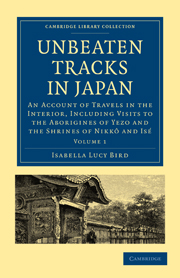 Unbeaten Tracks in Japan
Unbeaten Tracks in Japan Niigata, July 4.
The boat for Niigata was to leave at 8, but at 5 Ito roused me by saying they were going at once, as it was full, and we left in haste, the house-master running to the river with one of my large baskets on his back to “speed the parting guest.” Two rivers unite to form a stream over whose beauty I would gladly have lingered, and the morning, singularly rich and tender in its colouring, ripened into a glorious day of light without glare, and heat without oppressiveness. The “packet” was a stoutly built boat, 45 feet long by 6 broad, propelled by one man sculling at the stern, and another pulling a short broad-bladed oar, which worked in a wistaria loop at the bow. It had a croquet mallet handle about 18 inches long, to which the man gave a wriggling turn at each stroke. Both rower and sculler stood the whole time, clad in umbrella hats. The fore part and centre carried bags of rice and crates of pottery, and the hinder part had a thatched roof which, when we started, sheltered twenty-five Japanese, but we dropped them at hamlets on the river, and reached Niigata with only three. I had my chair on the top of the cargo, and found the voyage a delightful change from the fatiguing crawl through quagmires at the rate of from 15 to 18 miles a day.
To save this book to your Kindle, first ensure [email protected] is added to your Approved Personal Document E-mail List under your Personal Document Settings on the Manage Your Content and Devices page of your Amazon account. Then enter the ‘name’ part of your Kindle email address below. Find out more about saving to your Kindle.
Note you can select to save to either the @free.kindle.com or @kindle.com variations. ‘@free.kindle.com’ emails are free but can only be saved to your device when it is connected to wi-fi. ‘@kindle.com’ emails can be delivered even when you are not connected to wi-fi, but note that service fees apply.
Find out more about the Kindle Personal Document Service.
To save content items to your account, please confirm that you agree to abide by our usage policies. If this is the first time you use this feature, you will be asked to authorise Cambridge Core to connect with your account. Find out more about saving content to Dropbox.
To save content items to your account, please confirm that you agree to abide by our usage policies. If this is the first time you use this feature, you will be asked to authorise Cambridge Core to connect with your account. Find out more about saving content to Google Drive.